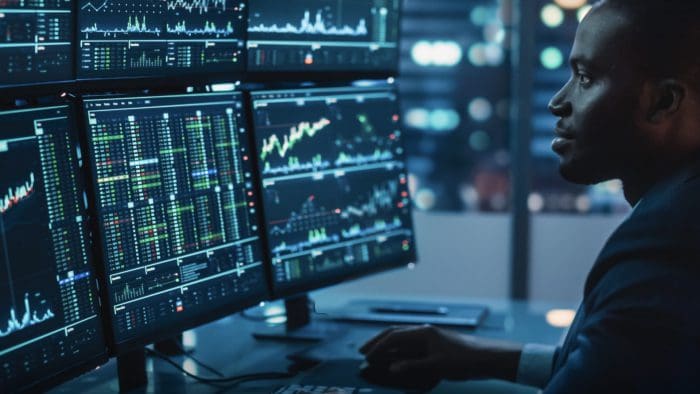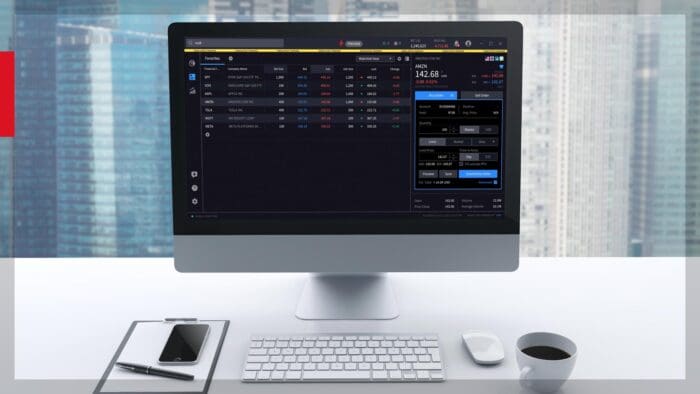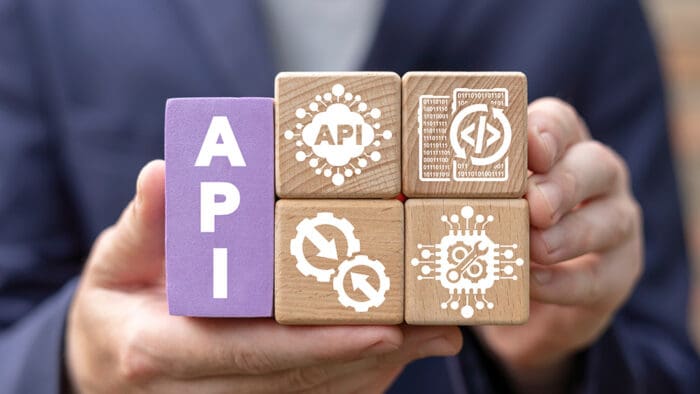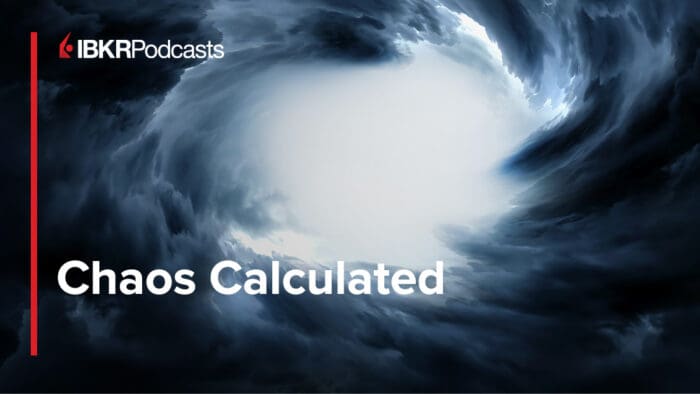Markets are swinging, spreads are widening, and volatility is king. NASDAQ experts Kevin Davitt and Nick Smith break down what’s driving the chaos, how traders are adapting, and where the next big opportunities might be. Buckle up—it’s a wild ride!
Summary – IBKR Podcasts Ep. 237
The following is a summary of a live audio recording and may contain errors in spelling or grammar. Although IBKR has edited for clarity no material changes have been made.
Andrew Wilkinson
It can’t have escaped your attention that stock market volatility has picked up during the first two months of 2025, especially as investors feel the pain of declines surrounding the so-called Magnificent Seven. Options volumes, meanwhile, continue to increase as investors embrace volatility and the charm of very short-dated options.
Options volumes tend to correlate well with rising volatility, but there comes that rare point in time when volatility is tipped from high to extreme. My guests today are used to dealing with the subject of volatility. Welcome to Kevin Devitt in Chicago and Nicholas Smith in New York, both from NASDAQ.
Welcome, gentlemen. How are you?
Kevin Davitt
I am doing well, Andrew. Thank you so much for having us. I’m excited to have this conversation.
Andrew Wilkinson
And Nicholas, you’re up from Miami to New York—
Nick Smith
Right. Braving the cold and the rain, but we’ve managed. Headed back today.
Andrew Wilkinson
Very good. So just for placement terms, we’re recording this on Thursday, the 6th of March, when the market has been down, up, and is back down again. We’ll be posting this event the following week, probably. Kevin Davitt is Head of Index Options Content at NASDAQ, and Nick Smith is Head of Index Option Sales at NASDAQ.
Kevin, what’s happening broadly with volatility in your space?
Kevin Davitt
Yeah, I’m excited to talk about that. I am going to try to focus on volatility more broadly as opposed to today or the past handful of days, Andrew, as that’s a topic that I find endlessly fascinating. And part of my interest there is the semantics and the behavioral element because volatility is one of those words where the connotation is often more powerful than its denotation or its technical definition.
By definition, volatility in capital markets is a fairly rote measure of how much an asset—or an index, in this case—moves from a mean over a given timeframe. Now, volatility measures in our business are typically annualized, and everything that I talk about in this conversation will be annualized.
That allows for kind of an apples-to-apples comparison when you’re discussing different products or different markets. They can be distilled and compared in volatility terms. All the points that Nick and I will make here today are described visually in charts that should be linked in the show notes. I think they can be very helpful if you’re listening along.
Now, on the point of connotation and denotation, what I mean there is that most investors only associate volatility with sell-offs, like we’re in the middle of now in early March. Volatility is used to describe market declines, by and large. Investors remember 2008 or 2023 as very volatile years, and they most certainly were. But volatility, by definition, is a non-directional measure.
And what this data that we’ve looked into showed me is that for the better part of the past 15 years, NASDAQ 100 volatility—or movement away from a mean—has been on the upside more frequently than on the downside. And I would take 2023 as an example: the NASDAQ 100 gained nearly 54% in that calendar year. That too is volatility.
So I think it’s really important to level-set that understanding of volatility for this broader conversation. It is a directionally agnostic measure. Now, to be abundantly clear, over long timeframes, equity indices typically decline with greater velocity than they climb. That is absolutely true. From an options trading and practical perspective, though, volatility is directly directionally agnostic—upside and downside vol.
But measures like index skew are one of the ways that market participants and Interactive Brokers clients can track that relationship between upside and downside volatility.
So now, let’s put a few numbers around this volatility talk. I don’t want to overwhelm an audience with numbers—I think that can be a little off-putting. But we’re talking about long-term data here, which, for these purposes, goes back to the beginning of 2008. So it incorporates what we typically refer to as the Global Financial Crisis and everything up until late February of this year.
Average NASDAQ 100 annualized volatility over that long timeframe works out to 21.3%. Now, let’s compare that to average S&P 500 annualized volatility over the same timeframe: 18.1%. So over the past two decades, on average, the NASDAQ 100 has been about 18% more volatile than the S&Ps.
I took the spread between the two measures—21.3 minus 18.1—and divided by 18.1 there. That reality has implications for the options associated with both products, and many option traders are drawn to NDX, the NASDAQ 100 index option, specifically because of that historical volatility premium.
I think that active market participants—the ones that you alluded to with these short-dated options—tend to see higher volatility as more opportunity to potentially monetize moves. And you have certainly seen that play out over the past few months with tech and consumer discretionary sectors, which are well represented in the NASDAQ 100, lagging when compared to things like financials or consumer staples.
Financials are not represented in the NDX, and consumer staples make up about 3.1%, a relatively small part of the NDX.
My last point here: you referenced the short-dated options growth, and we’re absolutely observing that in the NASDAQ 100 as a variety of market participants—many of them Interactive Brokers clients—have found ways to potentially monetize that shorter-dated exposure.
Andrew Wilkinson
Kevin, on that theme of blue chips versus technology names and the spread between them, can you describe some chapters over time when that spread between realized volatility on the NASDAQ 100 and the S&P 500 indices has widened or narrowed? And I should also ask, why did the spreads change?
Kevin Davitt
Really good question. I appreciate how you clearly articulated that we’re going to talk about realized volatility as opposed to the options-based forward-looking implied measure. Part of me—just the way you frame that—would like to have a semantics debate about blue chips.
I can’t help myself here. Did you know that the term “blue chips” dates back more than a hundred years and originally described components of the Dow Jones Industrial Average that had stock prices over 200 bucks a share? I didn’t know that until much more recently.
Andrew Wilkinson
Thanks to Google for that.
Kevin Davitt
Yeah, thank you. Thank you, search engine.
Now, both of us know—but maybe some of the audience doesn’t—that the Dow Jones Industrial Average is a price-weighted index, which is arguably a poor construction by modern standards. The highest-value chip in poker games was colored blue, and so that’s where the name derives from.
But here and now, I would argue that a company like Apple, the largest constituent in the NASDAQ 100, is a blue chip in 2025 by definition—kind of high-quality, financially healthy, and widely recognizable.
And I think that there have been periods where Apple corporate debt yielded less than similar sovereign debt, which speaks to how stable the financial community considers the firm.
Now, I mentioned to you, Andrew, that the average spread has the NASDAQ 100 realizing about three vols higher than the S&P’s. But averages can be instructive, yet they can also be deceiving, and I want to flesh that out a little bit.
So, the spread—that relationship that you referenced—moved as wide as 7 vols in 2022 and then turned slightly negative in 2009, and that’s what we’re going to dig into.
That realized volatility relationship has ranged from negative one—where the NASDAQ 100 realized lower volatility than the S&Ps—to positive seven. The extremes occurred in 2009, where it was negative, and in 2022, where it was the widest.
When I look at the charts or data, my eyes tend to go to the extremes. I examine when those events occurred and try to figure out what was going on at that point in time.
So, I asked myself: Why might NASDAQ 100 volatility have been lower than the S&Ps in 2009?
For those of us old enough to remember that timeframe, it was very unique, but let me spell it out for some of our younger listeners.
From a compliance perspective, I do want to make clear that this is just my opinion. But when I think about it, we have to consider the fact that the NASDAQ 100 includes the top 100 NASDAQ-listed securities, excluding financials. And in this situation, I think that very much matters.
The NASDAQ 100 does not include financial companies like banks, brokerages, insurance firms, or the like. The average S&P exposure to financials over this long timeframe is around 12%.
Financials were largely at the epicenter of the 2008 crisis environment, and as a result, in my opinion, that spread inverted. The lack of financials mattered from an overall volatility standpoint.
Now, it’s interesting to note that the second narrowest annual volatility spread was in 2020. These were both periods of massive NASDAQ 100 outperformance.
My takeaway here is that in crisis periods, which often involve high correlation, the spread between NASDAQ 100 volatility and S&P 500 volatility tends to narrow considerably.
In fact, between 2008 and 2015, the vol spread between the two indices averaged just one to one and a half vols. The inverse is also true—when the NASDAQ 100 underperforms, the spread tends to widen.
And I think it would be great to have Nick add a little bit of color on that side.
Nick Smith
Yeah, absolutely. Thanks, Kevin.
From post-2020 into 2021 and up until the present, that vol spread has been substantially wider. It has actually averaged six vols. And in 2022, it was at its widest, where during that timeframe, we observed it widening to 7 and 7.2 vols.
I think that situation is the opposite of what you had in 2008, so to speak.
If 2008 was the financial crisis, 2022 was the technology and growth crisis. Tech got crushed, NDX underperformed, and the spread widened substantially.
Last year, the realized vol spread between the two indices, NDX and SPX, was just under five vols.
And that spread—what’s critical is tracking this over time—has been coming down since 2022.
Big picture: These spreads narrow during times of crisis, like in 2009 and 2020. But they tend to widen as macro volatility declines. So, it shows that during these times of non-crisis, NDX is where volatility measures can still remain persistently high.
Andrew Wilkinson
Fascinating. Back to Kevin. Are there any implications of vol spread changes from an index price perspective?
Kevin Davitt
Ooh, I like that.
Alright, to be fair, I think in this conversation we run the risk of confusing correlation and causation, and I want to preface my response with that.
But at extremes, and given the benefit of hindsight, I think this data and conversation are interesting. So, let’s look at it from the perspective of a long-term investor.
Since the end of 2007, the NASDAQ 100 has gained more than 1,000%, compared to 485% for the S&Ps.
Now, to be clear, nearly 500% growth on the S&P side is nothing to sneeze at, but over the past two decades, the NASDAQ 100’s performance has dwarfed other large-cap indices, and that matters for passive investment dollars.
I’ve got to point out—you said it at the outset, Andrew—but we’re recording on March 6th, which marked a generational bottom in 2009. Since this date 16 years ago, the NASDAQ 100 is up just over 2,000%, and the S&Ps are up over 1,000%.
My point here is that, over time, the higher volatility in the NASDAQ 100 has paid off handsomely. I think it’s the price of admission.
But when you get into the nuance—which is what you’re asking about—when the realized volatility spread widens, as Nick just referenced, the NASDAQ 100 typically underperforms from a price perspective.
That was the case in 2013 when the vol spread got to about four and a half vols wide, and the NASDAQ 100 underperformed on a rolling annualized basis by 10% at its worst.
A similar dynamic from a vol spread perspective occurred in late 2016, and the NASDAQ 100 underperformed by 5% at its lows.
More recently—and many people will remember this—2022 saw the vol spread exceed 7 vols wide, and at its worst, the NASDAQ underperformed by 15%.
Now, the flip side of that: When volatility spreads have narrowed, the NASDAQ 100 has generally outpaced the S&Ps in price terms, which is what you were asking about.
In a couple of specific windows, that outperformance was very material. From a compliance perspective, let me be brief here.
The narrowest realized vol spreads coincided with significant NASDAQ 100 outperformance.
So, we’re talking again about 2009, when that negative vol spread saw the NASDAQ 100 outperform by 30%.
The spread got to nearly even in 2020, and the NASDAQ 100 outperformed by nearly 40% at its peak.
And more recently, following the market bottom—a local bottom in 2022—these dates are too symmetrical not to highlight.
The vol spread bottomed, and the underperformance stopped on December 27, 2022.
At that point, we were talking about the ChatGPT introduction and this broader AI boom. The vol spread started to narrow, and the NASDAQ 100 went from underperforming by more than 14% to outperforming by 31% exactly one year later.
You can’t make that stuff up. You can just look at the data, and that’s why these sorts of topics are so fascinating.
That type of data, I think, can inform the conversations that Nick has with the institutional community about where there might be opportunities associated with that.
Andrew Wilkinson
Nick, can you chime in then? You speak to trading desks and institutions. Chime in on the recent volume trends against that backdrop of wider vol spreads and how it might be impacting their systematic strategies and so on.
Nick Smith
Indeed. My job is speaking to hedge funds and asset manager desks involved in this from an institutional perspective.
And I think, importantly, from the exchange side, the development of the last five years—really across all exchanges that offer this type of product—has been completing the matrix of expiries.
So, adding weekly expiries, but specifically adding enough weekly expiries to now have essentially a daily expiry. And that’s what we see—having an expiry for each weekday.
To tie it into the previous conversation about the differences in the indices and why people listen to me talk when it comes to the NASDAQ 100 index option:
We see, for example, this week, even intraday moves in the S&P that are newsworthy.
Now, you can actually get those interesting moves in the NDX much more readily because of the nature of the volatility measures that Kevin just referenced.
While I’ll make no bones about retail flow being a driver within this index options boom—certainly post-pandemic, that’s definitely important—institutions are now using these daily expiries as a way to express daily volatility views, such as buying or selling volatility.
And we’re at an inflection point where we don’t just list these things, and suddenly institutions want to do a bunch of strategies. In fact, backtesting is a super important part of what they do.
So, we’re at an inflection point where the products have been alive long enough that those backtests and implementations can now occur at greater scale.
To give some flavor to the types of strategies that I talk about: In addition to the traditional tail risk hedging strategies that do well in times of market stress, we’re also seeing systematic and quantitative, black-box-style strategies—typically associated more with the futures market—being spun up in the index options universe because of this availability of risk exposure and the expiry matrix that we have.
One last thought: The NASDAQ 100 is generally where institutions go for volatility in the equity markets.
And as a result, not only in the types of strategies that retail traders implement, but also in these more quantitative types of strategies, NASDAQ 100 index options, as the underlying, are often outperforming their peers.
Andrew Wilkinson
Let’s bring the conversation up to modern recent history. I can think of two events that occurred.
Back in August, there was the yen carry trade—that exploded and caused devastation in the markets. It wreaked havoc.
And then the so-called Deep Seek Monday, which happened just recently in February.
How did both of those events play out at the index level?
Kevin Davitt
I’ll take that one, and if Nick wants to chime in, he’s more than welcome to.
I think I’ve talked a bit too much so far, and I love the points he just made, but my brief—hopefully brief—opinion here is that, despite the fact that the S&Ps have concentrated exposure in tech, consumer discretionary, and communication services, it just isn’t the NASDAQ 100.
And you can see those differences in situations or periods like the ones you just mentioned.
So, the first one—the carry trade unwind—I would argue, and I think the data bears this out, was less impactful on the NASDAQ 100 than on the S&Ps.
Now, again, I try to think about the “why” behind that. And I think it’s arguably a function, again, of the exclusion of financials.
If you think about who is at risk—what part of the ecosystem is at risk—when big, levered positions unwind in an ugly way, generally, it’s financials.
So, that day—August 5th of last year—was more S&P-centric. And Nick can elaborate on some of the specifics there.
Now, by contrast, the Deep Seek news coming out of China—this more efficient, potentially AI-driven model—was much more NASDAQ 100-centric.
And you can see how it played out in terms of the depth, the velocity of the sell-off, potential rebounds, and the sensitivity of implied volatility around these periods of uncertainty.
Nick is so good at digging into the data around these things, making sense of it with our economic research team and some of the quants that are part of our index options group.
And then having those conversations about NDX opportunities with the Street. So, we’re grateful for that.
Andrew Wilkinson
Nick, your thoughts on it?
Nick Smith
Yeah, absolutely.
In the show notes, I think we’re going to include an index performance summary during economic events—a one-pager that provides an overview of some of these numbers.
But just to pull a couple of numbers out there to illustrate the point:
On the yen carry trade date, both indices—the NDX and the SPX—dropped by 3%.
But on Deep Seek Day, NDX dropped by 3% in one day, while SPX only fell by 1.5%.
So, you’re seeing that difference at a price level, but more deeply, as Kevin pointed out, looking at other volatility measures—such as a 30-day at-the-money implied volatility measure—is even more telling about what’s actually going on under the surface.
And you can see, during the yen carry trade event, both NDX and SPX 30-day out-of-the-money implied volatility bumped two vol points.
But by contrast, on Deep Seek Day, that same measure bumped two vol points for NDX but only one vol point for SPX.
So, it’s not just about price; it’s also about implied volatility.
And all of this information is in the show notes for your listeners to take a look at. They can also reach out to me with any questions.
Andrew Wilkinson
Nick, who will find those event risk profiles of interest?
Nick Smith
Frankly, anyone tracking the market should be interested in taking a look at how the numbers play out.
I think what’s new is really comparing the different indices—taking a look at how these indices perform during different periods as market sentiment shifts and the types of investments that traders focus on change.
The NASDAQ 100-facing universe continues to grow, and I think we’re just beginning to scratch the surface across the board in terms of how the NASDAQ 100 index option can be a part of those investment decisions.
Just to mention—by the way—on my weekly distribution this week, those who are subscribed will have seen an analysis of the comparative attractiveness of NDX options in the wings, given current implied volatility measures.
Put another way, NASDAQ NDX wingy options—25 delta or smaller—may be cheap as a way to get volatility exposure.
So, your listeners are more than welcome to reach out to me to receive my weekly emails and take a look at not only how the index moves and how the implied volatility measure shifts, but also strategies associated with potentially profiting from those opportunities.
Kevin Davitt
Potentially making money, Nick. Potentially.
Andrew Wilkinson
My final question—and this is for both of you—what are you focused on, big picture-wise, over the remainder of the year?
Today, as we’re recording, the market’s a mess, politics is a mess, geopolitics is a mess, trade is a mess.
What else do you have to look forward to this year?
Kevin Davitt
I’ll start that one and then leave it to Nick to close us out.
You’re referencing here-and-now events, and they can certainly unsettle people and impact volumes.
Our team—hopefully, and I’m more focused on the content side—is able to continue telling compelling stories at the index level.
It’s my opinion that derivative products are, in so many ways, dependent on growth and interest in the index itself.
And so, we need to be consistent and compelling about those narratives—talking to individual investors, advisory-type clients, and Nick on the institutional side—about use cases where we can continue to evolve this narrative and compete in the index options landscape, which is our explicit intent.
And we have been growing significantly.
We’re excited about that.
Interactive Brokers clients have been a big part of that, and we want to see that continue.
Andrew Wilkinson
Nick, how are you going to save the world?
Nick Smith
I’m going to continue working with the institutional community, showcasing the types of information that we have as an exchange.
I like to work hand in glove with desks that may look to us for unique research into the NASDAQ 100 as it becomes an increasingly relevant part of the investment ecosystem.
And we’re here to be the index options provider in that space.
We’re excited about the growth.
Andrew Wilkinson
Brilliant.
Kevin Davitt, over in Chicago. Nick Smith, in New York—at least for now.
Thank you both so much for joining me. Fascinating discussion.
Nick Smith
Thanks for the time, Andrew.
Kevin Davitt
Thank you, Andrew.
Andrew Wilkinson
And thanks to you, the audience, as well.
Don’t forget—if you enjoyed today’s episode, please subscribe to the channel wherever you download your podcasts.
Disclosure: Interactive Brokers
The analysis in this material is provided for information only and is not and should not be construed as an offer to sell or the solicitation of an offer to buy any security. To the extent that this material discusses general market activity, industry or sector trends or other broad-based economic or political conditions, it should not be construed as research or investment advice. To the extent that it includes references to specific securities, commodities, currencies, or other instruments, those references do not constitute a recommendation by IBKR to buy, sell or hold such investments. This material does not and is not intended to take into account the particular financial conditions, investment objectives or requirements of individual customers. Before acting on this material, you should consider whether it is suitable for your particular circumstances and, as necessary, seek professional advice.
The views and opinions expressed herein are those of the author and do not necessarily reflect the views of Interactive Brokers, its affiliates, or its employees.
Disclosure: Nasdaq
Index
Nasdaq® is a registered trademark of Nasdaq, Inc. The information contained above is provided for informational and educational purposes only, and nothing contained herein should be construed as investment advice, either on behalf of a particular security or an overall investment strategy. Neither Nasdaq, Inc. nor any of its affiliates makes any recommendation to buy or sell any security or any representation about the financial condition of any company. Statements regarding Nasdaq-listed companies or Nasdaq proprietary indexes are not guarantees of future performance. Actual results may differ materially from those expressed or implied. Past performance is not indicative of future results. Investors should undertake their own due diligence and carefully evaluate companies before investing. ADVICE FROM A SECURITIES PROFESSIONAL IS STRONGLY ADVISED.
© 2023. Nasdaq, Inc. All Rights Reserved.
Options
For the sake of simplicity, the examples included do not take into consideration commissions and other transaction fees, tax considerations, or margin requirements, which are factors that may significantly affect the economic consequences of a given strategy. An investor should review transaction costs, margin requirements and tax considerations with a broker and tax advisor before entering into any options strategy.
Options involve risk and are not suitable for everyone. Prior to buying or selling an option, a person must receive a copy of Characteristics and Risks of Standardized Options. Copies may be obtained from your broker, one of the exchanges or The Options Clearing Corporation, One North Wacker Drive, Suite 500, Chicago, IL 60606 or call 1-888-OPTIONS or visit www.888options.com.
Any strategies discussed, including examples using actual securities and price data, are strictly for illustrative and education purposes and are not to be construed as an endorsement, recommendation or solicitation to buy or sell securities.
© 2023. Nasdaq, Inc. All Rights Reserved.
Disclosure: Options Trading
Options involve risk and are not suitable for all investors. For information on the uses and risks of options, you can obtain a copy of the Options Clearing Corporation risk disclosure document titled Characteristics and Risks of Standardized Options by going to the following link ibkr.com/occ. Multiple leg strategies, including spreads, will incur multiple transaction costs.
Disclosure: Forex
There is a substantial risk of loss in foreign exchange trading. The settlement date of foreign exchange trades can vary due to time zone differences and bank holidays. When trading across foreign exchange markets, this may necessitate borrowing funds to settle foreign exchange trades. The interest rate on borrowed funds must be considered when computing the cost of trades across multiple markets.

















Join The Conversation
For specific platform feedback and suggestions, please submit it directly to our team using these instructions.
If you have an account-specific question or concern, please reach out to Client Services.
We encourage you to look through our FAQs before posting. Your question may already be covered!